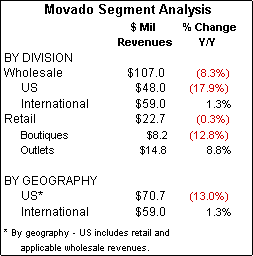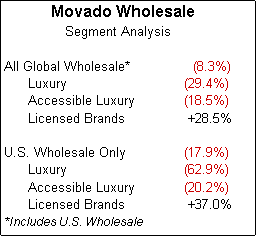IDEX Online Research: Movado’s Strategy Softens Economic Blows
September 16, 08
 Source: Company |
Movado’s strategy to help soften the blows from economic weakness is interesting – and likely to be successful: it has introduced new ultra-high-end product and it is expanding merchandise which will sell at the lower end of its historic price point range.
At the high end, it introduced men’s mechanical watches which are selling for $300,000 or more at retail; demand has been very strong, and there is a backlog for Swiss mechanical movements which had delayed shipments for very high end watches. At the lower end, the company is designing watches to see in the $200-300 range, especially in the ESQ brand, somewhat below its more normal range with prices up to $500.
The reason this strategy makes sense is this: in periods of economic weakness, the middle mass market weakens first and dives deepest. In contrast, high-end “old-money” consumers typically continue to spend. Often the low end of the market expands: middle market consumers spend “down” – they spend less on goods, and they often need credit. Thus, lower-end, credit jewelers often see an increase in store traffic; the biggest impediment to sales is getting a customer’s credit application approved. While Movado isn’t opening accounts that we would consider “credit jewelers”, management recognizes that the lower end of the market is expanding, and it is creating product to fill demand in that niche.
The following table summarizes Movado’s financial results for the second fiscal period ended July 2008.

Source: Company
The following are highlights from Movado’s second quarter.
- Reported net sales were $129.7 million, down 7 percent from the second fiscal period last year. However, if $8.3 million of one-time liquidation sales are excluded from last year, and currency translation of +$6.6 million is excluded from this year, sales were down a slightly more moderate 6 percent year-over-year in constant dollars.
- As the first table (above) illustrates, wholesale sales in international markets were up slightly. An increase in revenues from the company’s licensed brand market expansion generated incremental revenues of $5.9 million. Further, currency translation boosted results by $6.6 million. Without the currency swing, international wholesale sales would have been down.
- Movado’s wholesale sales into the U.S. market were down by nearly 18 percent in the second fiscal quarter. Virtually all of its key brands – Concord, Ebel, Movado, and ESQ – reported a decline in sales to key retail accounts, with the largest portion of the sales decline coming from its “accessible luxury” brands of Movado and ESQ.
- Licensed brands – including Coach, Tommy Hilfiger, Hugo Boss, Juicy Couture, and Lacoste – generated a 28 percent revenue increase for the company. Revenues for licensed brands were up in both the domestic market and international markets.
The table below summarizes Movado’s wholesale business, both on a global basis (all markets including the U.S.) as well as a break-out of the U.S. market wholesale sales.
 Source: Company |
- Management commented that its U.S. wholesale business was stronger in mall department stores than in jewelry stores in those same malls.
- Movado closed roughly 1,400 wholesale doors in the U.S. market earlier this year. This represents about a one-third reduction from its total of 4,000 doors a year ago. These 1,400 doors generated less than 5 percent of sales and less than 2 percent of profits. As a result of these closings, Movado’s U.S. wholesale sales per wholesale door have risen to about $1,850 in the second quarter, up 26 percent from just over $1,450 a year ago. With higher sales per door, efficiencies of scale will help boost profits.
- In its retail business, Movado is seeing more strength in its outlet stores than its boutique units. Total sales in the 29 boutique stores were down 12.8 percent, while sales in the outlet stores rose by 8.8 percent. In the past, Movado provided same-store sales; it no longer publishes this information, though it appears that same-store sales are very close to total sales trends, since the number of stores is relatively stable year-over-year.
However, for the first time, Movado has provided enough information for us to calculate sales per store by each concept. In the second quarter, Movado Boutique stores generated about $282,000 in revenues, down from last year’s $323,000. Movado Outlet stores generated about $477,000 in revenues, up from last year’s $439,000. Based on our best estimates, Movado Boutique annual sales per store are probably in the $1.2-1.3 million range, a level which is not profitable for the company. Movado Outlet annual revenues per store are probably in the $1.7-1.8 million range, which is on the cusp of profitability for these types of stores, but well below the revenue volume we would expect from a highly successful outlet store. Movado previously brought in a consultant to help the company understand what it will take to make its retail division profitable. Further, the company announced that it has hired a new president for the Movado retail division – Diane Fox – who came from Liz Claiborne where she was vice president of the specialty retail division.
- The company’s gross margin rose both on a reported basis – 64.7 percent from last year’s 59.8 percent – and after elimination of one-time unusual items – 64.7 percent versus 63.6 percent last year without liquidation sales. Margins were higher in both the accessible luxury division and the licensed watch division. A favorable currency translation valuation also helped boost the company’s gross margin.
- Operating expenses rose as a percentage of sales in the second fiscal quarter. Currency translation hurt, and there were a variety of other minor factors that drove up operating costs. The company previously announced a program to save about $25 million in annual operating costs; this would be fully realized in 2009. The company is reducing its payroll cost by 10 percent, which represents about 90 filled positions and 6 percent of the company’s full-time workforce. The payroll reductions are spread primarily across its corporate and “shared service” departments, mostly in its U.S. and European operations.
Management’s outlook provided mostly guidance for Wall Street analysts related to earnings per share. While management noted that earnings per share this year are likely to be about flat with last year, it is important to note that the company will likely have about 10 percent fewer shares outstanding at year-end. Management also reiterated that it has a goal to achieve an operating margin in the mid-teen range next year. That’s an aggressive goal, especially in light of the current economy.